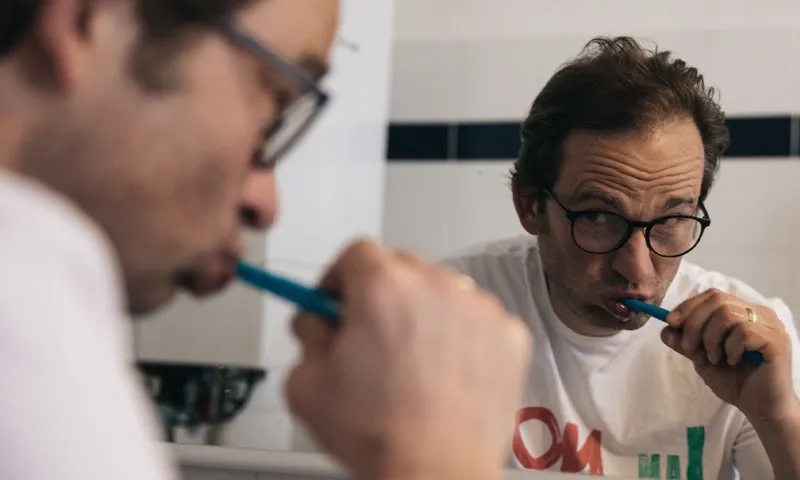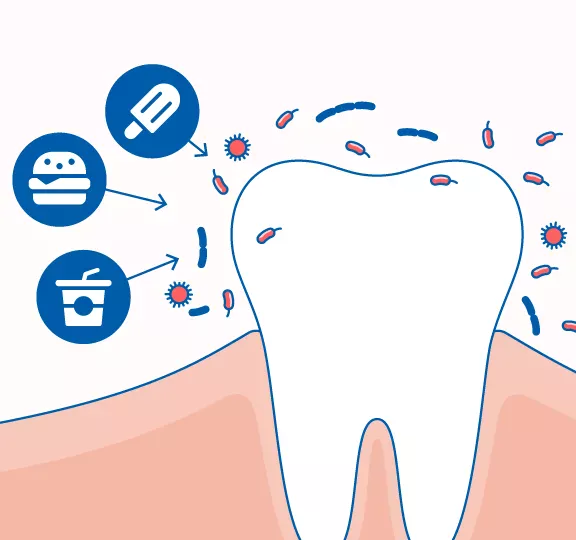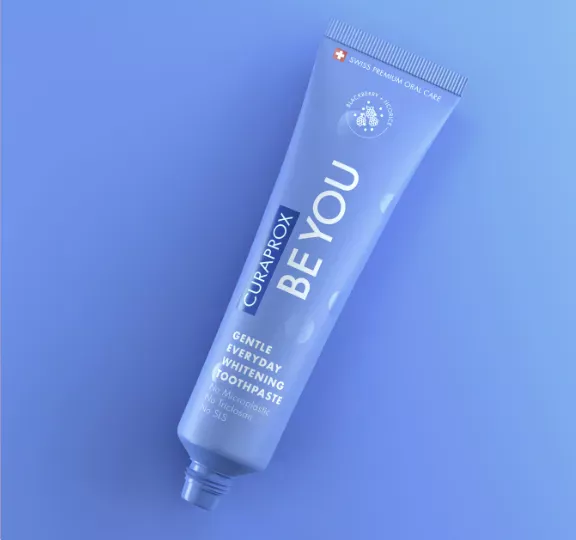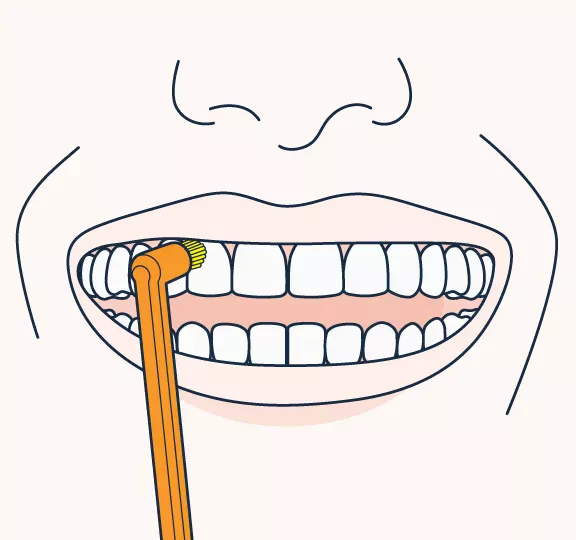Why this guide?
SENSITIVE TEETH PAIN RELIEF
Because:
- You want to feel the relief of stopping sensitive teeth pain. Or…
- You want to learn from the Curaprox experts about sensitive teeth symptoms, how to prevent them, what causes them and what you can do about them
Step one
What causes sensitive teeth?
Learn about sensitive teeth symptoms and the causes of sensitive teeth pain…
What does tooth sensitivity mean?
Do you feel a short, stabbing pain or longer-term discomfort when:
- Eating or drinking hot or cold food or drink?
- Consuming sweet or acidic food or drink?
- Brushing your teeth?
- Or just breathing in cold air?
It’s an unpleasant sensation and it can start to get you down.
Fortunately, sufferers can often deal with the problem by consistently following a series of simple steps. Keep reading!
(Please contact a dental professional with serious problems or if your symptoms do not improve.)
What causes sensitive teeth?
Tooth enamel protects dentine – the softer tissue found beneath it.
If the enamel is damaged or starts to thin, it exposes the dentine, which can lead to pain and sensitivity.
There are a number of causes for the loss of tooth enamel including brushing too hard, tooth grinding and acid erosion (see below).
Receding gums expose the root surfaces of the teeth (the “tooth necks”), which are not protected by enamel, and can also cause tooth sensitivity.
And teeth whitening patients often experience sensitivity after treatment.
How to prevent acid erosion on teeth
You should take special care with acidic food and drink such as cola and other soft drinks, energy drinks, fruit and fruit juices…
… because the acidity attacks the structure of your tooth enamel.
So too much exposure to these foods and drinks can damage the enamel.
To help combat this:
- Enjoy drinks like orange juice or cola as a treat only
- Take a sip of water after consuming acidic food or drink
- Don’t brush your teeth straight after acidic food or drink – the enamel will be weakened and susceptible to damage… so wait at least half an hour
Step two
Sensitive teeth toothpaste
Choose the right sensitive teeth toothpaste to tackle and ward off sensitive teeth pain…
Choosing the right toothpaste is crucial – as are brushing the right way with a gentle, effective toothbrush… and being careful about what you eat.
Using a low-RDA toothpaste with Hydroxylapatite – such as Curaprox Be you – strengthens enamel…
… and actually creates a smooth surface.
What is best for sensitive teeth? Hydroxylapatite
Laboratory tests have now shown that, with regular brushing, Hydroxylapatite – a rare but naturally occurring mineral – creates a sealant for sensitive teeth…
… which also gives your teeth a beautiful, smooth glow.
The ultrapure Hydroxylapatite microcrystals found in Curaprox Be you toothpaste:
- Remineralise and recalcify damaged tooth enamel
- Heal tiny defects on the surface of the tooth
- Reduce the sensitivity of exposed root surfaces
- Close openings that expose dentine – stopping some of the painful stimuli from reaching the nerve
- Reach deep into the layers of the tooth to combat tooth decay
Use a low RDA sensitive teeth toothpaste… and beware of strong whitening toothpastes
The higher the Relative Dentin Abrasivity (RDA) score of a toothpaste, the more abrasive it is…
… and the more likely it is to erode the enamel on your teeth because of harsh, abrasive ingredients such as sodium metaphosphate, zirconium silicate and calcium pyrophosphate.
Similarly, strong whitening toothpastes with harsh ingredients can lead to enhanced sensitivity
Introducing Curaprox Be you – the ultimate sensitive teeth toothpaste
Curaprox Be you toothpaste means:
- The exceptional healing and protection of Hydroxylapatite
- Low RDA (RDA approx 50)
- You can Be you and express with six fresh flavours – grapefruit + bergamot, peach + apricot, watermelon, gin tonic + persimmon, blackberry + liquorice, apple + aloe…
- Beautiful herbs and natural ingredients including extracts of echinacea, bitter orange, devil’s claw and Indian pennywort to nourish the tissue that lines your mouth… and help to stop inflammation
- A touch of tasty sweetness with birch sugar (xylitol), which also strengthens your teeth and fights bacteria
- Power bubbles with a refreshing blast of menthol
- As well as helping sensitive teeth, it cares for your gums and gives you long-lasting fresh breath
Be you Express yourself. What’s not to love?
We recommend:
Step three
Toothbrushes & interdentals
Use the best toothbrushes for sensitive teeth with the best technique – together with interdental brushes…
Brushing vigorously with a hard toothbrush can lead to all sorts of problems.
Dental hygiene practice owner Edith Maurer Bussink says many people cause “a lot of damage by brushing too much with a hard toothbrush using excessive pressure”.
“If too much pressure is always used, particularly with a medium hard or even hard toothbrush, it has an abrasive effect on the teeth over time,” she says. “The gums also recede and the necks of the teeth are exposed.”
Brushing in this way erodes the teeth enamel and can lead to teeth sensitivity.
Edith Maurer’s guide to the best way to brush your teeth & gums
Brushing your teeth and gums twice a day in the following way can help you to deal with and prevent teeth sensitivity…
“Position the brush correctly: half of the bristles on the teeth, the other half on the gum,” Edith Maurer says.
“The brush is held at a slight angle so that the bristles point towards the gumline. You now brush in small circles, using as little pressure as possible.”
She adds that it’s crucial to use “a particularly soft brush with very fine bristles” – such as the Curaprox CS 5460 toothbrush.
“Fine bristles penetrate the gumline easily,” she adds. “And particularly soft to avoid damaging the gumline.”
All Curaprox toothbrushes, both manual and sonic, use fine and gentle Curen® filaments – instead of conventional nylon.
Sonic toothbrush for sensitive teeth
For those who prefer them, sonic toothbrushes “make brushing that bit easier”, Edith Maurer says.
The Curaprox Hydrosonic pro was designed by Prof. Dr. med. dent. Ueli P. Saxer.
It features a sensitive head for careful tooth cleaning and oscillates with up to 42,000 sonic waves per minute.
Edith Maurer adds: “This is so fast that the mixture of saliva, water and toothpaste is literally swirled around in the mouth. This mixture gets to the plaque between the teeth - and at high speed. The plaque is simply cleaned away, even in those hard to reach areas.”
Solo brushing for precise care with sensitive, receding gums
Edith Maurer also recommends the “solo technique” – cleaning the gum line around each individual tooth with precise movements using the Curaprox CS 1006 single-tuft brush.
Using this method the solo brush is the ultimate way to clean – and avoid inflammation – in the gum line.
In turn, you can avoid:
- The formation of biofilm – or plaque – in the gum line…
- … thus avoiding further inflammation…
- … thus avoiding receding gums…
- … thus avoiding exposed tooth necks!
That is a whole lot of sensitive teeth pain avoided!
This technique is also perfect for taking care of your oral health if you suffer from receding gums and exposed teeth roots.
Use interdental brushes as part of your daily routine
Brushing the “interdental” spaces – the small gaps between the teeth – every day with Curaprox CPS prime interdental brushes can prevent receding gums and the sensitivity caused when the necks of the teeth are exposed.
“It’s best to have your dentist or dental hygienist show you how to do this properly,” says Edith Maurer. “This will also ensure that you use the correct size of the interdental brush. If they are too small, they won’t clean well and if they are too big, they can cause damage.”
We recommend:
Further information
Ask your dentist
You should now be much more knowledgeable about dealing with – and preventing – teeth sensitivity!
Please ask your dental professional if you want more information about treating sensitive teeth and caring for your oral health.
 Swiss premium oral care
Swiss premium oral care



















